- Luật
- Hỏi đáp
- Văn bản pháp luật
- Luật Giao Thông Đường Bộ
- Luật Hôn Nhân gia đình
- Luật Hành Chính,khiếu nại tố cáo
- Luật xây dựng
- Luật đất đai,bất động sản
- Luật lao động
- Luật kinh doanh đầu tư
- Luật thương mại
- Luật thuế
- Luật thi hành án
- Luật tố tụng dân sự
- Luật dân sự
- Luật thừa kế
- Luật hình sự
- Văn bản toà án Nghị quyết,án lệ
- Luật chứng khoán
- Video
- NGHIÊN CỨU PHÁP LUẬT
- ĐẦU TƯ CHỨNG KHOÁN
- BIẾN ĐỔI KHÍ HẬU
- Bình luận khoa học hình sự
- Dịch vụ pháp lý
- Tin tức và sự kiện
- Thư giãn

TIN TỨC
fanpage
Thống kê truy cập
- Online: 5
- Hôm nay: 265
- Tháng: 3395
- Tổng truy cập: 5148659
2018 timeline contents
2018-2048 —
Uganda is an oil-producing nation
2018 —
A missile defence shield is deployed in Europe
The first private supersonic jet
The African Central Bank is established
East Africa's largest ever infrastructure project
South Korean city Pyeongchang hosts the Winter Olympics
Russia hosts the FIFA World Cup
The James Webb Space Telescope is launched
Japan lunar rover mission
The Japanese Hayabusa-2 probe arrives at 1999 JU3
Completion of the 100,000 Genomes Project
Universal flu vaccine
Polio has been eradicated
A drug to prevent obesity
Crossrail opens in London
The Transbay Transit Center is completed in San Francisco
Many complex surgeries are performed by robots
Robot insect drones are in military use
Enterprise-grade SSDs reach 128TB of capacity
Consumer devices with 100 Gbit/s transfer speeds
Portable, long-range 3D scanning
Scientists drill into Earth's mantle
The Mackenzie Valley Pipeline is completed in Canada
The market for biofuels is experiencing a period of rapid growth
The last of Nigeria's rainforests have been felled
2018-2048
Uganda is an oil-producing nation
Commercially viable oil in Uganda was discovered in 2006, with an estimated 3.5 billion barrels of reserves. However, it would take over a decade for production to start, due to a series of political, social, economic and technical issues. These included a lack of transparency in the planning process, corruption among officials, intimidation and poor compensation of local residents, sluggish progress in determining the best infrastructure, and general bureaucracy.
By 2012, a total of 77 wells had been drilled and investigated, with 70 showing potential for profit. In 2013 the government finally reached an agreement with Tullow Oil of the United Kingdom, Total of France and the China National Offshore Oil Corporation (CNOOC), to build both the oil refinery and pipeline. Uganda also partnered with the neighbouring countries of South Sudan, Kenya and Rwanda to take up ownership in the planned oil refinery. Once the remaining issues were worked out, construction would begin in 2014, with first production in 2018.*
Most of the oil was located in the Albertine Graben region, a 45 by 500 km stretch of lush green vegetation, home to about half of Africa's bird species, along with baboons, antelopes and elephants. Serious concerns were therefore raised by environmentalists, but these were dismissed by the government. With at least 30 years of production capacity, Uganda would undergo an economic boom – bringing electricity to the 90% who had lived without it, boosting its education and healthcare systems, and shifting the nation into the league of upper-middle-income countries.
This new-found wealth could not last, however. In the longer term, serious environmental problems would plague not just Uganda, but much of the African continent. Landlocked and lying directly on the equator, Uganda was exposed to extreme climate risks, including substantial changes in rainfall and humidity.*
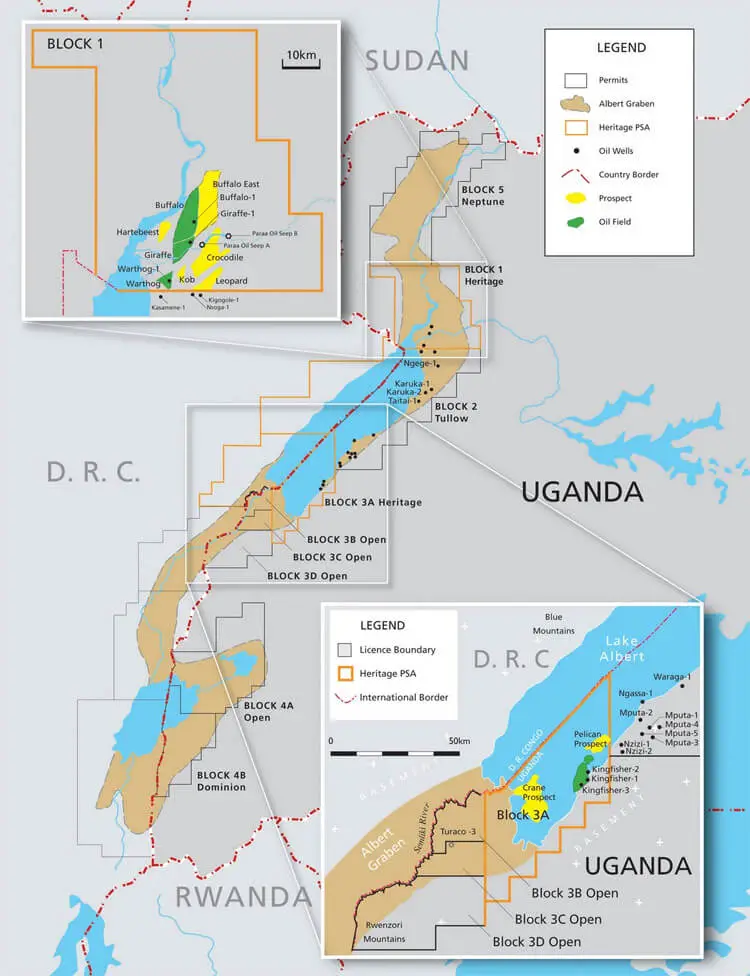
Uganda oil map. Credit: Heritage Oil
2018
A missile defence shield is deployed in Europe
Europe is now protected by a continent-wide missile defence system, developed and deployed by the US military.
This has been established in phases between 2011 and 2018.
Phase 1 saw the deployment of a land-based early warning radar – which Turkey agreed to host – as well as ships in the Mediterranean equipped with proven SM-3 interceptors.
Phase 2 saw the creation of a land-based SM-3 interceptor site in Romania – in order to expand the defended area against short- and medium-range missile threats.
Phase 3, the most significant phase, added a more advanced SM-3 interceptor (Block IIA) and a second land-based SM-3 site, which Poland agreed to host. This would counter short-, medium- and intermediate-range missile threats. The system is located at Redzikowo military base, close to the Baltic Sea and Lithuania, roughly 50 miles from the Russian exclave of Kaliningrad.*
An additional fourth and final phase will be completed in 2020 with missiles being upgraded.*
Initially, this defence shield resulted in a cooling of relations between the US and Russia. The latter expressed concerns over the presence of missiles so close to its border, which it viewed as a security threat. This was despite assurances from the US that the shield was for potential threats from Iran and the Middle East – and was neither designed nor capable of threatening the numbers and sophisticated ability of Russia's strategic forces.*
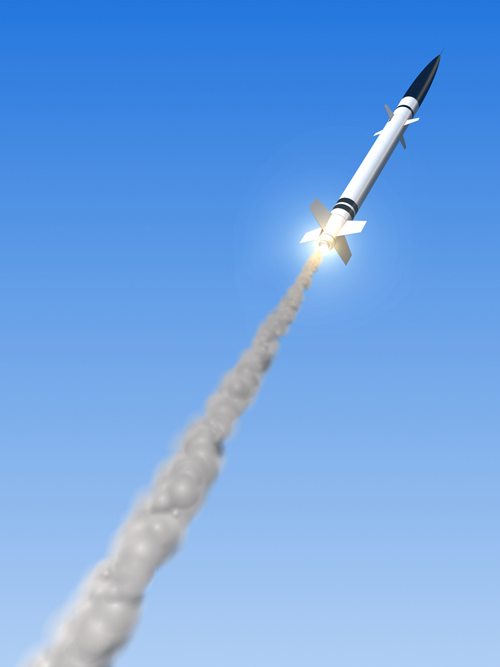
The first private supersonic jet
While commercial airliners typically cruise at Mach 0.85 (567 mph), the Spike S-512 uses advanced engine and airframe technology to reach speeds of Mach 1.8 (1200 mph). Holding up to 18 passengers, it can fly from NYC to London in 3.5 hours instead of 7 hours; or from LA to Tokyo in 8 hours instead of 16 hours.*This private jet, costing $80 million, is aimed at the richest business executives and celebrities, but supersonic and even hypersonic travel will become more affordable in future decades. A competitor, Aerion, delivers their own supersonic jet in 2023. This is followed by larger hypersonic commercial airliners in the 2030s.
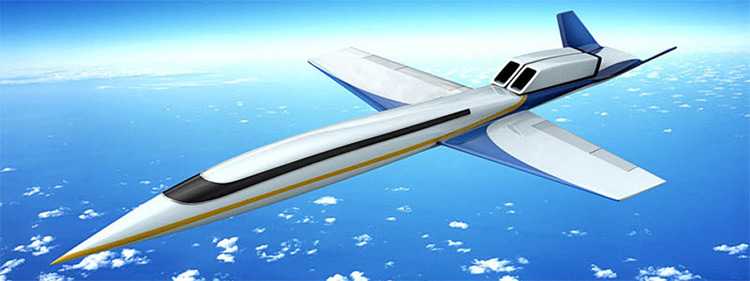
Credit: Spike Aerospace
The African Central Bank is established
Following many years of diplomatic talks, a unified African Central Bank has been established.* This represents a crucial step towards a more stable and developed Africa.
Though international efforts made in recent years, mostly as part of the UN's Millennium Development Goals, the continent still had numerous problems to deal with. Despite medical advances and socio-economic progress, famine and disease were on-going issues. In the north, residual tensions and instability remained, following the protests and uprisings that raged earlier in the decade. The Horn of Africa was plagued by drought and civil unrest, while piracy off the coast of Somalia had only increased as oil and other commodities rose in value.
It became clear in recent years that a lasting and meaningful prosperity could only be achieved by the entire continent working together as one. Following the 2011 overthrow of its main proponent, Muammar Gaddafi, the plan for a United States of Africa came to be regarded as a dead proposal. However, countries were working together in other ways. The East African Federation, for instance, was established in 2015.**This was a full political federation of five member states – Burundi, Kenya, Rwanda, Tanzania and Uganda – creating the second most populous nation in Africa (after Nigeria).
The growing need for a larger, more unified and far-reaching financial institution, in order to be fully integrated with the global economy, has led to further progress in developing the African Central Bank. Finally established in 2018, the benefits of this continental bank are immediate and substantial. Now acting as the banker for the African Union (consisting of 54 individual states), the Central Bank is able to regulate trade standards and currency value – supporting both public and private banking while setting interest and exchange rates.
The next step will be creating a pan-African single currency – known as the "Afro" – on schedule to take place in the early 2020s.* It is hoped that this development will be the keystone to helping each nation in the long term, especially the poorest, with value fluctuations and inequality becoming less and less rampant. The free movement of goods, persons, services, labour and capital will do much to improve the regional economy. A human rights court and monetary fund will also be set up. In addition, Africa finds itself in a uniquely advantageous position, in that it can learn from the past mistakes of Europe and the Euro. A prosperous and stable Africa now appears within sight for the first time.
However, true economic prosperity is still a far-off goal for most of the people of Africa, whose population has swelled to over 1.3 billion.* The looming threat of climate change will be the continent's biggest challenge of all.
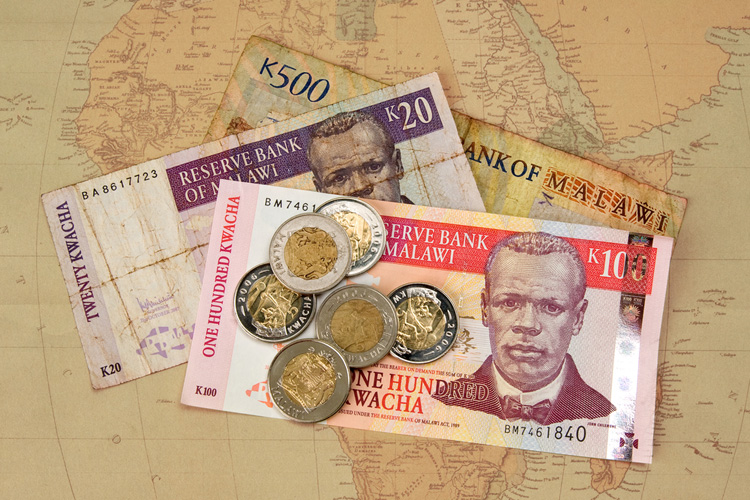
East Africa's largest ever infrastructure project
This year sees a major rail network completed in East Africa.** Built by a Chinese state-owned firm and part-funded by China's government, the $14bn Standard Gauge Railway (SGR) is the largest infrastructure project in the region's history. The SGR connects a number of major cities – greatly boosting trade and investment while reducing the times needed to move people and goods across borders. The cost of sending a tonne of freight one kilometre is slashed from $0.20 to $0.08, with a typical journey between Nairobi and the port city of Mombasa cut from 12 hours to just four. Until now, the region had relied almost exclusively on road transport.
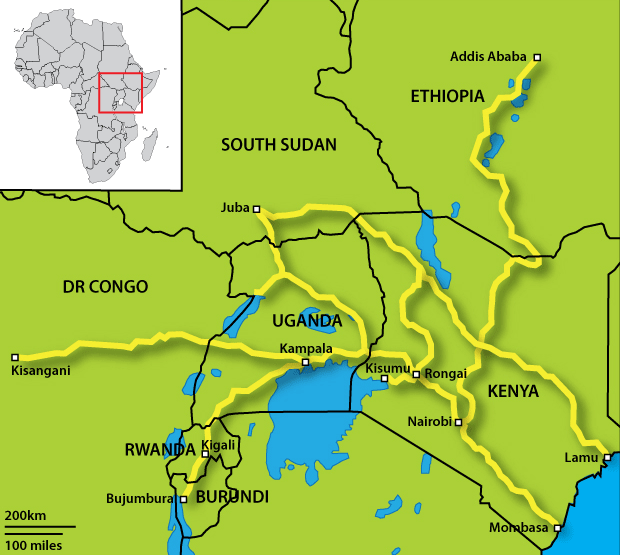
South Korean city Pyeongchang hosts Winter Olympics
The 2018 Winter Olympics take place from 9th February to 25th February 2018, in Pyeongchang, South Korea. The elected host city was announced by the International Olympic Committee (IOC) in July 2011. Pyeongchang won on its third consecutive bid, having lost previously to Vancouver in Canada and Sochi in Russia. It is the first Winter Olympic Games and second Olympic Games in South Korea; the 1988 Summer Olympics were held in Seoul. Pyeongchang is also the third Asian city to host the Winter Games after Sapporo, Japan (1972) and Nagano, Japan (1998). It is the first Winter Olympic Games since 1992 to be held in a ski resort town. In June 2015, four new disciplines were approved for inclusion in the games: snowboarding big air; curling mixed doubles; speed skating mass start and Alpine skiing team.

Russia hosts the FIFA World Cup
This is the first time Russia has hosted the World Cup. Some $10 billion are spent on the tournament, which is spread over 14 venues including Moscow and St. Petersburg. As of 2010, there were no stadia in the country with 80,000+ capacities, but Luzhniki Stadium in Moscow is expanded to 90,000 seats in time for the games.
The James Webb Space Telescope is launched
The James Webb Space Telescope (JWST) is the long-awaited successor to the Hubble Space Telescope. Its primary mirror has a collecting area six times larger than Hubble. The telescope is situated in an L2 orbit approximately 1.5 million km from Earth. Originally planned for 2014, it was delayed until 2018 due to budgetary constraints.*

Japan lunar rover mission
In 2018, the Japan Aerospace Exploration Agency (JAXA) sends an unmanned mission to the Moon. This uses an Epsilon solid-fuel rocket to carry and deploy a "Smart Lander for Investigating Moon" (SLIM). The probe is designed to perfect soft-landing technologies for manned missions in the future. While previous attempts by space agencies have landed spacecraft within several kilometres of their target site, SLIM aims to land within 100 metres (approximately 328 feet).*Face recognition software, similar to that found in digital cameras, enables it to identify craters. The mission costs ¥10 billion to ¥15 billion (between $83 and $125 million). Only five nations have achieved soft landings on the lunar surface – the former Soviet Union, the USA, China, India and Japan.
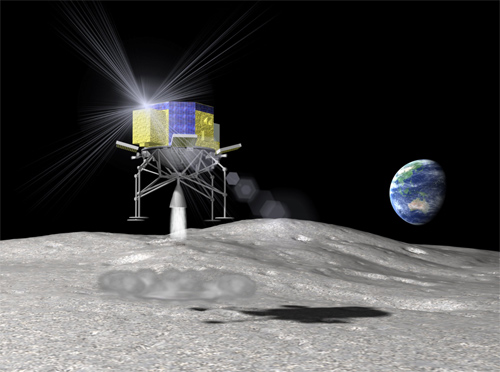
The Japanese Hayabusa-2 probe arrives at 1999 JU3
1999 JU3 is an Apollo asteroid – a group of asteroids whose orbits take them into the main belt, before drifting back towards Earth's vicinity. In 2018, this kilometre-sized rock is investigated by Japan's space agency, JAXA. The mission involves a probe, Hayabusa-2, launched in 2014 and arriving four years later. The spacecraft is equipped with a "cannon" that fires a 7 kg (15.4 lb) explosive projectile at a velocity of 2 km/s. This impacts the asteroid's surface with such force that a new crater is formed, with a camera filming the event from above. Hayabusa-2 then lands in the crater – scooping up samples for analysis back on Earth. It is hoped that water and organic materials in these samples may help to explain the origin of life.*
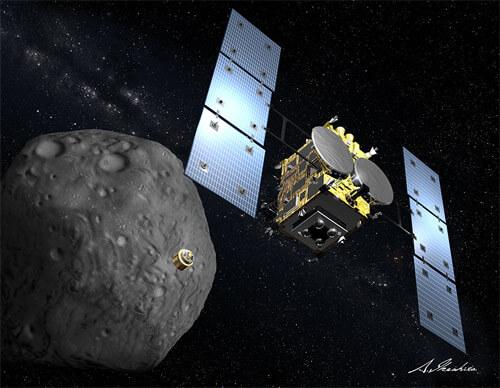
Completion of the 100,000 Genomes Project
The 100,000 Genomes Project is a £300 million ($467m) effort to sequence the genomes of National Health Service (NHS) patients in England between 2015 and 2018.* By utilising a huge sample size, it aims to identify common genetic traits behind a number of cancers and rare diseases, paving the way for new diagnostic tools, drugs and other treatments.
When the Human Genome Project was initiated in 1990, it cost $3 billion and required 13 years to complete. However, the time and expense of mapping a whole human genome began to fall exponentially, at a rate even faster than Moore's Law witnessed in computer chips.* By the early 2010s it was possible to sequence a person's DNA for less than $10,000 in a few days, and by 2014, machines capable of $1,000 genomes had appeared.* A new era of personalised genomics was beginning to emerge.*
The 100,000 Genomes Project takes advantage of these revolutionary advances to create a large-scale database, combining genetic information with personal health records. This helps researchers to better understand disease and its complex relationship with genes. Doctors can predict how well a person will respond to a particular treatment, or find one that works best for their specific case. It allows health organisations to more accurately track the spread of infectious disease, precisely pinpointing the source and nature of an outbreak. All data in the 100,000 Genomes Project is anonymous.*
England is the first country to undertake such a task,* but even larger projects follow in subsequent years, as genome sequencing continues to improve in both cost and speed. By 2020, tens of millions of human genomes have been sequenced. By 2040, these systems will be ubiquitous in countries around the world.*The impact of personalised medicine is on a scale similar to penicillin and the smallpox vaccine.*
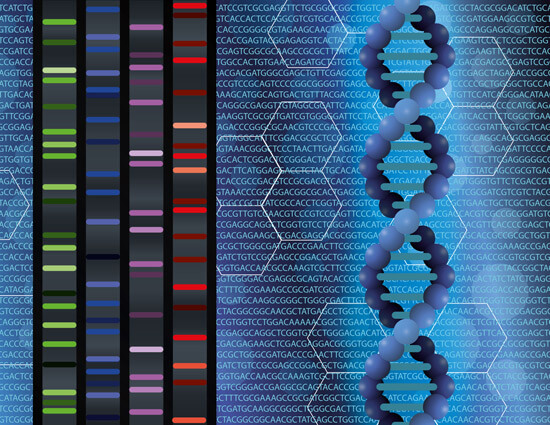
Universal flu vaccine
Influenza, commonly known as "the flu", is a serious disease that causes between 250,000 and 500,000 worldwide annual deaths, rising to millions in pandemic years. It can sometimes lead to pneumonia, either direct viral pneumonia or secondary bacterial pneumonia, even in persons who are usually very healthy. Because of the way it can modify proteins on its outer surface, influenza is constantly evolving. This means that vaccines quickly become useless and new versions are required each year.
However, researchers found that material on the inside was common to many strains of the virus. By targeting this core region – that never changes, even in new strains – it was hoped that a universal flu vaccine could be developed that would be effective against all current and future outbreaks.
A type of white blood cell known as CD8 – part of the body's immune system – was found to recognise proteins in the core. Using blood samples from human volunteers, taken during the 2009 pandemic, it was discovered that patients with higher levels of CD8 T-cells had milder symptoms and less chance of developing flu. By identifying the exact subtype of the immune system giving protection and which components of the virus it was attacking, researchers were able to develop a "blueprint" for a vaccine that could stimulate production of these T-cells.* Following further years of research, the vaccine is made publicly available by 2018.*

Polio has been eradicated
Polio is a disease caused by a virus that enters through the mouth. Spread by poor sanitation and exposure to infected human stools, it can damage the nervous system, leading to paralysis and eventual death. During the first half of the 20th century, there was a dramatic rise in cases. Epidemics became regular events during summer months, affecting hundreds of thousands of people. It was especially prevalent among young children.
This provided impetus for a "Great Race" towards the development of a vaccine. Developed in the mid-1950s, polio vaccines began to reduce the global number of cases per year. The last naturally occurring cases in the United States were reported in 1979 and the Western Hemisphere was declared free of the disease by 1994.
However, it continued to affect countries in Africa, Asia and elsewhere.* Vaccination efforts were stepped up – led by Rotary International, UNICEF and the World Health Organization. New commitments were made by governments and philanthropists including Bill Gates,* enabling over a billion children to be vaccinated. By 2018, polio has been eradicated from the world. New knowledge about the viruses, new technologies and new tactics to reach the most vulnerable communities have consigned it to history.* This is only the second time that a human disease has been completely wiped out; the previous instance was smallpox in 1979.*

A drug to prevent obesity
A drug that lets people eat whatever they want without gaining weight is being developed.* This works by tricking the body into reacting as though it has already consumed a meal. Though initially expensive, there is enormous demand for this product, leading to a rapid fall in obesity levels throughout much of the world – especially in countries like the US, which until now had been experiencing a crisis in this regard. Average life expectancy is increased as a result, since there are less people dying of heart-related illnesses.

Crossrail opens in London
In development since 1974, Crossrail is finally opened this year. One of Europe's largest ever transport projects, this boosts London's subway capacity by over 10%, bringing huge regenerative benefits.
The line is 120 km in length (including 42 km of tunnels) and runs from Berkshire in the west, to Essex in the east, linking together all the main economic hubs in the capital – Heathrow Airport, the West End, the City of London and Canary Wharf. Ten-coach trains, 200 metres long, run at frequencies of 24 trains per hour in each direction during peak periods.
The original planned schedule was for the first trains to run in 2017. A Comprehensive Spending Review in 2010 – saving over £1bn of the £16bn projected costs – meant that the first trains to run on the central section would be delayed until 2018.*
The Transbay Transit Center is completed in San Francisco
The population of California has continued to grow and grow. This has created some of the worst urban traffic problems in America. One of the places most badly affected has been the San Francisco Bay Area.
The main transport hub in downtown San Francisco had since 1939 been the original Transbay Terminal, located in the South of Market Neighborhood near the Financial District. In 2010, however, to address increasing stresses on the transportation system, this old station was demolished to make way for a new, high-tech development – something which had been in planning since the 1960s.
Demolition began in 2010, with a temporary station built to handle traffic over the seven year construction period. The first phase of the $4bn project would be completed in 2017. This would include a five storey, 1,400 foot long, million square foot transit centre, complete with numerous bus terminals, each with ramps connecting the stations to a new off-site bus storage facility and the nearby Oakland Bay Bridge. A 5.4 acre park would be included on top of the transit centre. The highly efficient re-design of the bus ramp system opened up parcels of land for a series of buildings which – together with the transit terminal – would make up San Francisco's grand urban renewal project. This part of the project would cover 40 acres and consist of townhouses, low to mid-rise buildings and skyscrapers, along with parks and recreation, overall providing 2,600 new homes, three million square feet of office space and over 100,000 square feet of retail space. The centrepiece of this development is the Transit Tower. Soaring to over 1,000 feet, it is among the tallest towers on the American West Coast, second only to the Wilshire Grand Center in Los Angeles.
The second and final phase – completed in 2018* – is the Downtown Rail Extension. This 1.3 mile long, primarily underground rail line connects the California commuter rail line, Caltrain, to downtown San Francisco, linking the city to the Peninsula, San Jose and Silicon Valley. This major extension opens the doors for new jobs and very rapid commutes in and out of the city. It is also made to accommodate the future California High Speed Rail Line. Overall, the project connects Caltrain, Greyhound, Golden Gate Transit, Muni, SamTrams, AC Transit, Bay Area Rapid Transit (BART), WestCAT and Amtrak.
The development is designed with the environment in mind, too. Its open design allows for natural light, low-energy ventilation and passive cooling. LED lights are used extensively, while many buildings including the Transit Tower are outfitted with wind turbines. Another key feature is that the entire development is built to withstand earthquakes; a likely possibility in the Bay Area.
Once completed, the Transbay Transit Center helps to accommodate the rapidly growing population of California – predicted to rise from 37 million in 2010, to 51 million by 2030.*
Many complex surgeries are performed by robots
Basic robotic surgeons have been around since the 1990s. In the first decade of the 21st century, they remained uncommon and relatively simple, though high-end companies began to develop their own more advanced models.*
Surgeries were divided between supervisory-controlled systems, telesurgical systems and shared-control systems. Supervisory-controlled systems were the most automated – requiring a human only to input directional data, and to supervise the operation to take control if anything went wrong. Shared-control systems were the least automated, in which human surgeons were physically present and did most of the work, but were aided by robots.
Though yet to become widespread, many large hospitals and universities had their own automated systems in place by 2010. Continued tests and trials of these machines greatly improved their accuracy and reliability. The growing number of successful surgeries made patients more willing to trust in robotic procedures.
By the mid-2010s, many cardiothoracic, gastrointestinal and orthopaedic surgeries could be handled almost entirely by remote-controlled robots. By 2018, the majority of large hospitals in the developed world use a robotic surgeon on at least a semi-regular basis. South Korea in particular is leading the way in this field, with almost every hospital in the nation using them routinely.* The latest models feature improved dexterity and multitasking, high quality incision tools and higher levels of automation. New ultra-small cameras are also in use, giving controllers an extreme close-up view of the operation.*
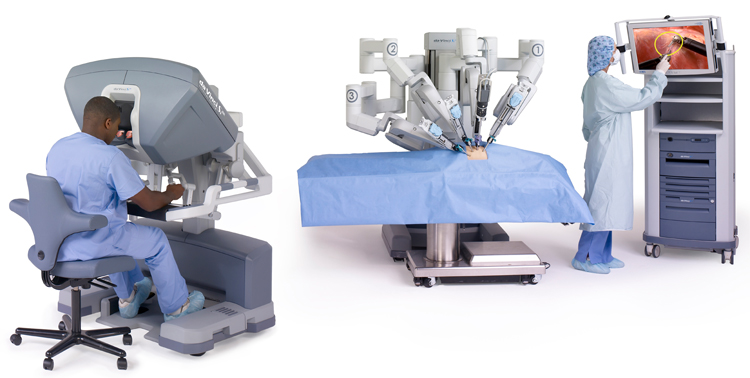
©2011 Intuitive Surgical, Inc.
Previously, it could take a dozen surgeons, anaesthetists and nurses to perform surgeries, with even more for certain complex procedures. Now, robots can remove some or all of this burden, performing the jobs of several different specialists at once and working around the clock without tiring.* Surgeries in 2018 often consist of just one or two human supervisors overseeing a robot's work. In the long run, this helps to reduce health costs. Additionally, robots offer much higher precision than humans, so patients are able to leave the operating table with less collateral trauma.
Telesurgery is now being looked into as a way for doctors to conduct surgeries over long distances. This could allow a specialist surgeon in England to operate on a patient in Australia for example, using only remote-controlled robots. However, issues with latency will delay this practice from entering the mainstream for a while yet.
Despite being another profession threatened by automation, hospital surgery remains a primarily human undertaking for now. Robotic operations are still in their infancy, requiring the presence and supervision of doctors and other personnel. It will be a long time before human medics are made entirely redundant by this technology.
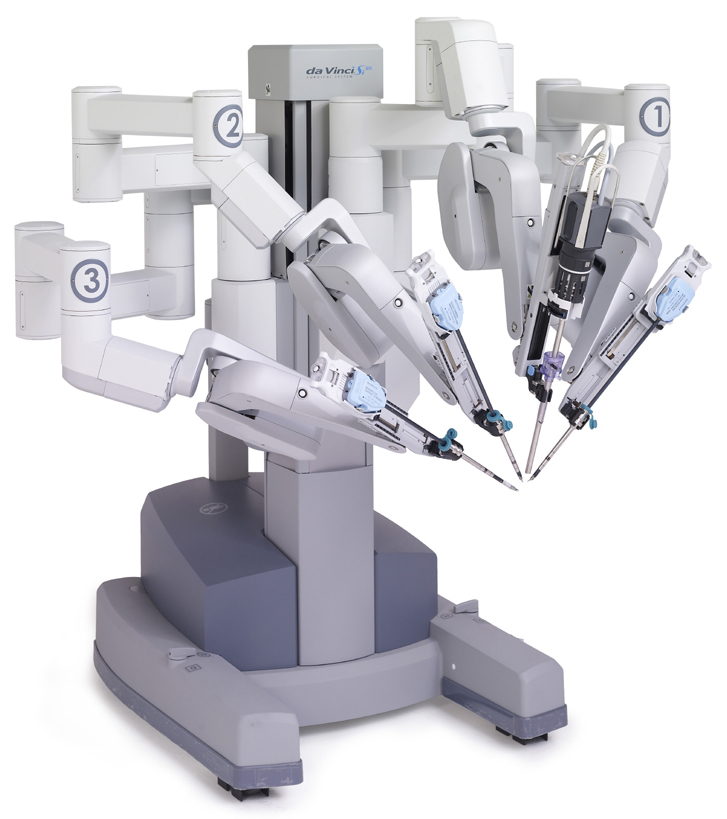
©2011 Intuitive Surgical, Inc.
Robot insect drones are in military use
Micro aerial vehicles the size of insects have been in development for over a decade.* One of the major hurdles was creating sufficient battery power in such a small object, as well as keeping them light enough to remain airborne. They are now entering military use in a number of roles – from spying missions (where they quite literally serve as a "fly on the wall"), to search and rescue operations* where they can easily navigate tight corners and spaces.
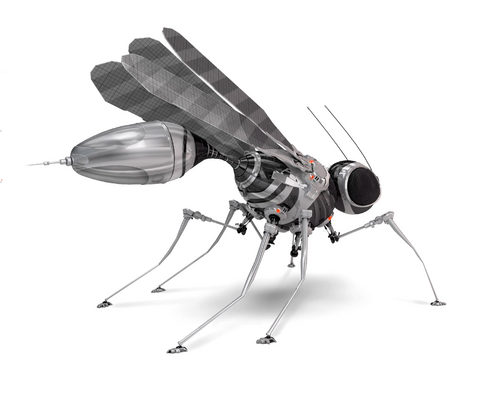
Enterprise-grade SSDs reach 128TB of capacity
Solid state drives (SSDs) have recently begun to overtake spinning drives in terms of storage capacity.* The largest of the enterprise-grade models are now reaching 128TB of capacity, with conventional HDDs lagging further behind. The gap between these storage methods will continue to accelerate as flash memory and similar technologies reach unprecedented densities in the 2020s.* The demand for consumer versions is being driven by rapid growth in 4K video adoption, enormous video game file sizes and other data-hungry applications.
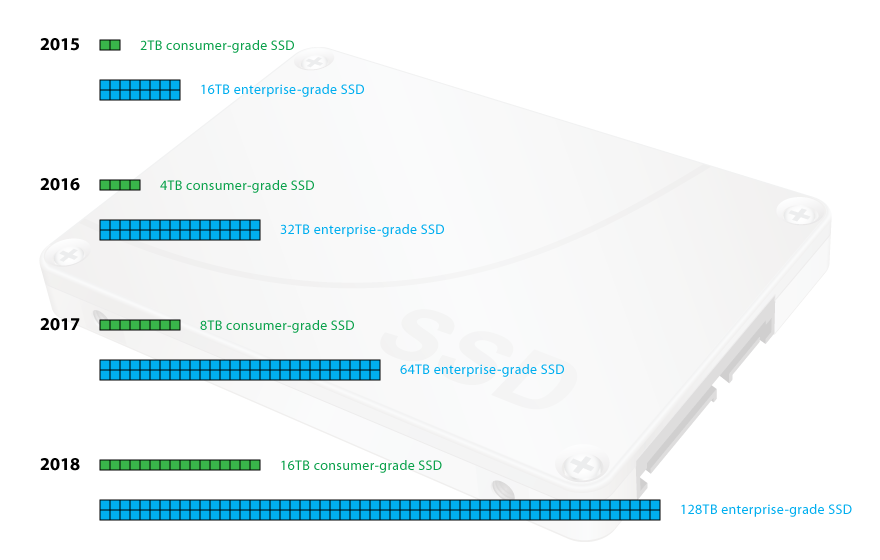
Consumer devices with 100 Gbit/s transfer speeds
A new form of data transfer has recently become available for the consumer market. This is known as "Thunderbolt" and replaces the Universal Serial Bus (USB) leads which have been the standard for many years. The USB 3.0 specification allowed transfer speeds of 4.8 Gbit/s. An early version of Thunderbolt (codenamed "Light Peak") achieved 10 Gbit/s. This latest version, however, can achieve 100 Gbit/s – enough to transfer an entire Blu-ray movie in just three seconds.*Optical technology used in Thunderbolt also allows smaller connectors with longer, thinner and more flexible cables. Additionally, it can run multiple protocols simultaneously over a single cable, enabling the technology to connect devices such as peripherals, workstations, displays, disk drives, docking stations and more.
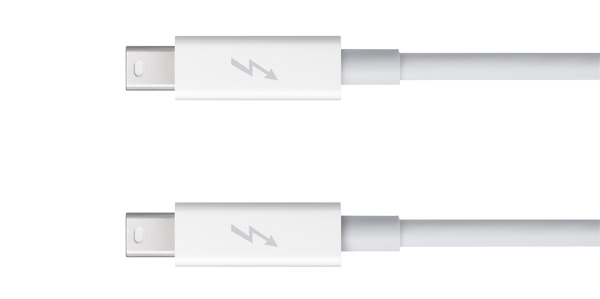
Credit: Intel
Portable, long-range 3D scanning
Recent advances in time-of-flight (ToF) systems, based on extra long wavelengths, have enabled 3D scans to be obtained from up to a kilometre away using handheld devices. This range will soon be extended to 10 kilometres, with millimetre accuracy. Applications include the scanning of static, man-made targets such as vehicles, identification of objects hidden behind foliage, remote examination of the health and volume of vegetation and the movement of rock faces to assess hazards.* This is adding to privacy concerns over the explosion of security and surveillance emerging at this time.
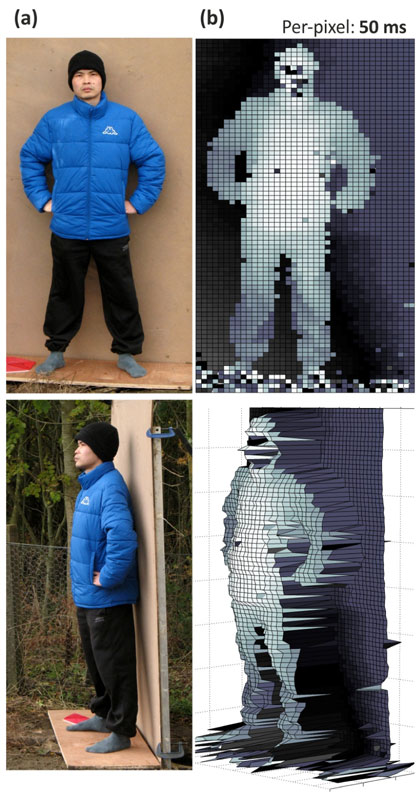
Credit: Optics Express
Scientists drill into Earth's mantle
In 2018, the first successful attempt is made to retrieve samples from Earth's mantle, the part of the planet that lies between the crust and the outer core. What was once considered science fiction has now become possible thanks to advances in drilling technology.*
The operation takes place in the Pacific, where the crust is much thinner, but still requires burrowing through some five miles (eight kilometres) of solid rock. Temperatures range from 500-900°C (932-1,652°F) at the upper boundary with the crust, while pressures exceed 4 million pounds per square foot (21 million kilograms per sq m). Seawater is pumped down into the hole at sufficient pressure that samples can be forced back up to the surface.
Until now, little has been known about the mantle, since the only samples to arrive at the surface have come from volcanoes or ancient mountain belts. Now for the first time, scientists can analyse "pure" extracts directly from the mantle, untainted by time or geological processes. This data reveals much about Earth's origins and early history. In addition, it provides insight into how current mantle processes operate: highly important in understanding the plate tectonics which drive earthquakes, tsunamis and eruptions.
Microbial life is also discovered at previously unexplored depths within the lower crust. These new forms of extremophile bacteria are found to survive at extraordinarily high temperatures – increasing the probability of alien life elsewhere in the universe.

The Mackenzie Valley Pipeline is completed in Canada
Like its European cousin, Nabucco, the Mackenzie Valley Pipeline had to overcome numerous obstacles in order to be realised. This giant energy project had been at the planning stage for 35 years, the main barrier to completion being the opposition of native tribes whose land it was intended to run through.*
By 2011, however, many tribes had dropped their opposition. This change of opinion was mainly a result of the Canadian government pledging billions of dollars to the aboriginal First Nations of Canada. Indeed, the Nations would eventually come to own one-third of the pipeline itself. With project approval given, work on the pipeline and the natural gas fields it would exploit began in 2014, with the first flow of gas starting in late 2018.*
In total, Mackenzie Valley stretches 743 miles (1,196 kilometres), beginning at the Beaufort Sea and passing through the Northwest Territories, before connecting to existing pipelines in northern Alberta. Around 18.5 billion cubic metres of gas pass through the pipeline each year. The total cost of this project is almost $22 billion.
Although much of the boreal forest the Mackenzie Valley runs through has been protected, concerns are still raised about the environmental impact. Many are worried about the increased development of the Canadian wilderness which the project's success encourages. Other huge gas and oil projects are underway in the region at this time. These include drilling in the Arctic National Wildlife Refuge, as well as the Alaska Gas Pipeline due for completion by 2020. The latter will be over twice as long as the Mackenzie Valley Pipeline.
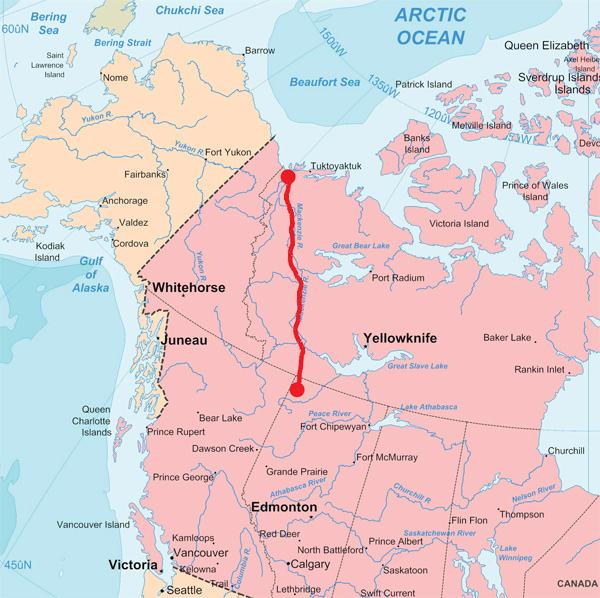
The market for biofuels is experiencing a period of rapid growth
Biofuels have been generating enormous interest over the last decade. Spikes in fossil fuel prices, the urgent need for energy independence, government subsidies and concern over greenhouse gas emissions have all driven the growing market for fuels such as ethanol, propanol, butanol, biodiesel, biomass and organic oil-based compounds.
By 2018, demand for alternative energy has spurred the industry to new heights. Ethanol production has been ramped up worldwide, now surpassing $100bn in value, compared to $35bn just a decade earlier.* Production from corn alone has jumped to over 20bn gallons.* Brazil remains a leading producer and user of ethanol, more than doubling its exports to 16bn gallons.* Due to its 40-year-old program, it retains the most advanced biofuel economy in the world, with ethanol easily surpassing fossil fuel use.
Government subsidies have been particularly high in the USA, as the need to reduce dependence on foreign oil becomes ever stronger. A significant percentage of American cars now run on biofuel, with gasoline use having fallen by almost 20%. The US Navy has also turned to biodiesel, which has now reached a reasonable price range for the task. It is hoped this will lead to the world's first truly "green fleet."*
The European Union has also increased its use of biofuel, which now makes up almost 10% of fuel. The EU remains the second largest producer, following Brazil. Italy has become the first country in Europe to legally require a new generation of "advanced biofuels" in its cars and trucks.* Russia today is a leading biomass producer, as it alone holds almost 22% of the world's forests.
Africa is now becoming a major exporter of biofuels through international corporations, particularly in Mozambique and Tanzania.* Jatropha cultivation in the area is producing over 40,000 tonnes of oil annually. India and China have significantly increased their production too.
Despite these gains, biofuel remains controversial. The land required for production competes with that of food, at a time of increasing food demand worldwide. Ethanol production is blamed for numerous agricultural price shocks during this decade and the next. It also contributes to soil erosion, deforestation and water loss. Some solutions now emerging include the aquatic and algae biofuel market, along with a focus on non-food biofuel sources.**
While biofuel is now making a noticeable difference in energy use worldwide, it is still too early to end the planet's reliance on fossil fuels.
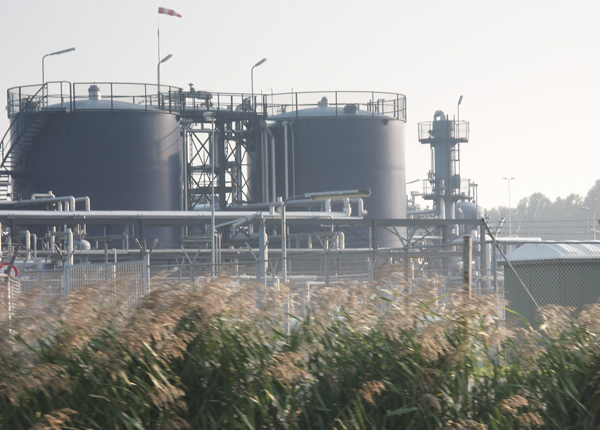
The last of Nigeria's rainforests have been felled
Nigeria was once among the Earth's most ecologically vibrant places – home to 4,700 plant types and 550 species of breeding birds and mammals. These included the forest elephant (Loxodonta cyclotis) and rare primates such as the drill monkey (Mandrillus leucophaeus), Sclater's guenon (Cercopithecus sclateri), the red-eared guenon (Cercopithecus erythrotis) and the red-capped mangabey (Cercocebus torquatus).
During the late 20th century, however, rampant deforestation took hold, with tree loss reaching nearly 4% per year. Between 1990 and 2005, the country lost over 4 million hectares of tree cover.* The most biodiverse ecosystems – the so-called "old growth" areas – were disappearing at an even faster rate, with an average of 11% being lost every year from 2000 onwards.
Logging, subsistence farming, road building (often sponsored by oil companies), mining and dam construction all contributed to the damage. The carbon lost from the destruction of these rainforests was exacerbated by the amount released from gas flaring – Nigeria flared more gas than any other country.
Despite some attempts at preservation, a resource-hungry population and its growing economy were unable to halt the tide of destruction. The bulk of Nigeria's rainforests eventually disappeared, the last few pockets shrinking into insignificance by the late 2010s.*
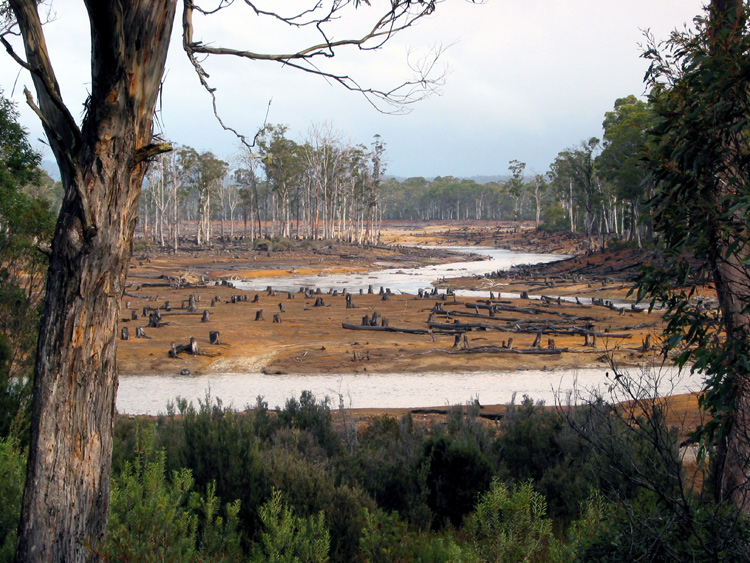
Các bài viết khác
- 2017 timeline contents (03.12.2015)
- 2016 timeline contents (03.12.2015)
- Hồ sơ mật Những người kiến tạo nước Mỹ Phần 1 (13.11.2015)
- MiG 35 Russia's Answer to the F 35 (13.11.2015)
- Sống để làm gì - TT. Thích Chân Quang (13.11.2015)
- Tổng hợp vũ khí hiện đại Việt Nam đã nhận 2015 (13.11.2015)
- Tu 160 ' White Swan '! Wings of Russia (13.11.2015)
- Video việc Trung Quốc đang xâm chiếm và xây dựng trái phép ở Biển Đông phần 2 (13.11.2015)
- VTC14 Tìm thấy dấu vết mới của sự sống trên sao Hỏa (13.11.2015)
- White swan TU 160 (13.11.2015)
- Wings of Russia. MiG-25 and MiG-31. Best In Class (1 of 2) (13.11.2015)
- Why Quantum Physics Ends the Free Will Debate (13.11.2015)
- Welcome to the 2030s Future Timeline Events 2030 2039 (13.11.2015)
- Welcome to the 2020s Future Timeline Events 2020 2029 (13.11.2015)
- Những hình ảnh từ Sao Hỏa khiến thế giới phải kinh hoàng (13.11.2015)
- Sáng chế robot thay con người làm việc nhàm chán, nguy hiểm (13.11.2015)
- Phỏng vấn Chủ tịch Hiệp hội Thủy sản Mỹ Nguồn VTV (13.11.2015)
- Robot vận tải của Thủy quân lục chiến Mỹ (13.11.2015)
- Xi Jinping: A 21st-century Mao? (13.11.2015)
- Worst Idea Ever: Dropping Nuclear Bombs During the Vietnam War (13.11.2015)
- Will South China Sea Dispute Lead to World War? (13.11.2015)
- Why the United States and Vietnam Urgently Need to Deepen Ties (13.11.2015)
- Why NAFTA passed and the Trans-Pacific Partnership failed (13.11.2015)
- What it will take for a head transplant to work (13.11.2015)
- What is civic capitalism? An interview with Colin Hay (13.11.2015)
- What China dangerously underestimates about America's interest in the South China Sea (13.11.2015)
- What Caused capitalism? (13.11.2015)
- Weaponized The "China Card" Makes Its Return to U.S. Politics (13.11.2015)
- We have heard that the Secretary General of the Vietnam Communist Party (13.11.2015)
- Vladimir Putin 2015 (13.11.2015)
- Vietnam Muddles China's South China Sea Challenge (13.11.2015)
- Vietnam 40 Years Later (13.11.2015)
- Việt Nam đang ngồi nhìn? (13.11.2015)
- Với TPP Việt Nam sẽ trở thành cường quốc hàng hải 2030 (13.11.2015)
- Vì sao căn hộ nhỏ ở đô thị đang là mốt? (13.11.2015)
- U.S. to Vietnam: Stop Hosting Putin’s Jets Please (13.11.2015)
- US to Press China on Island Expansions (13.11.2015)
- Turf wars Vietnam s land rights crisis (13.11.2015)
- Tuổi Già Hải Ngoại Và Niềm Vui Internet (13.11.2015)
- TƯ BẢN Thế kỷ XXI (13.11.2015)
- Trung Xô luận chiến công khai (13.11.2015)
- Trung Quốc cưỡng chiếm trái phép Hoàng Sa (13.11.2015)
- Vị thế của Mỹ đang bị thách thức (12.11.2015)
- Tranh giành Quyền lực và Hòa giải Dân tộc (12.11.2015)
- TPHCM: Nguồn cung căn hộ tăng mạnh trong quý 3/2015 (12.11.2015)
- Tinh dầu thông đỏ chữa ung thư: Thần dược hay lừa đảo (12.11.2015)
- Tiền vẫn đổ vào bất động sản Hà Nội (12.11.2015)
- Thời sự và suy ngẫm, số 97 (12.11.2015)
- Thế nào là tướng có phúc khí? (12.11.2015)
- The Bloodthirsty Deng We Didn’t Know (10.11.2015)
- Tình hình 2011 và Ba kịch bản cho thị trường bất động sản đến cuối năm (10.11.2015)
- SECRETARY KISSINGER (10.11.2015)
- PHỐ ĐÔNG VILLAGE BIỆT THỰ, NHÀ PHỐ TỐT NHẤT TP. HCM, KĐT (10.11.2015)
- TPHCM khai thác nhà xưởng cao tầng đầu tiên (10.11.2015)
- Ông chủ Sơn Kim Land: Kinh doanh căn hộ cao cấp cũng giống như ngành thời trang (10.11.2015)
- Áo dài người Việt (09.11.2015)
- Chủ tịch vương triều Tập có những điểm yếu của mình (09.11.2015)
- Những thế cờ Hoa Kỳ - Trung quốc (09.11.2015)
- Nhật đang đổ bộ đầu tư vào bất động sản Việt Nam (09.11.2015)
- NGƯỜI MÊ PHỞ NÓI CHUYỆN PHỞ...! (09.11.2015)
- Ngập lụt đô thị - phải làm gì bây giờ? (09.11.2015)
- Năm năm nhìn lại chuyên đề tiền tệ 2011 (09.11.2015)
- Doanh nghiệp bất động sản như ngồi trên lửa (09.11.2015)
- Mỹ so với Trung Quốc: Chiến tranh là không thể tránh khỏi, chỉ cần? (09.11.2015)
- MÙA ĐÔNG ĐẾN SỚM VÀ NHẬT BẢN VỀ ĐÊM (09.11.2015)
- MUA BÁN NHÀ KHÔNG THÀNH XỬ LÍ RA SAO? (09.11.2015)
- 'Khó thay đổi lớn về chính trị ở VN' (09.11.2015)
- Hiểm họa Trung Quốc và bài học từ Tiệp Khắc, Ukraina (09.11.2015)
- Giá bất động sản - sự phi lý trong cái hợp lý (09.11.2015)
- Giá bán căn hộ tại TPHCM và Hà Nội quý 4/2015 vẫn khó (09.11.2015)
- Về giải quyết tranh chấp, khiếu nại, tố cáo về đất đai (09.11.2015)
- Dự báo 20 năm ( 2014-2034) (09.11.2015)
- Dự án Đảo Kim Cương đã bán được hơn 60% căn hộ (09.11.2015)
- Doanh nghiệp bất động sản như ngồi trên lửa (09.11.2015)
- Col Liu Mingfu on the U.S. and China as Rivals (09.11.2015)
- Chuẩn bị chiến tranh với Trung Quốc (09.11.2015)
- Chủ quyền Hoàng Sa – Trường Sa? (09.11.2015)
- Chủ nghĩa tư bản và khủng hoảng tài chánh toàn cầu Vietsciences- Nguyễn Trường (09.11.2015)
- China Stands by Its Claims Over South China Sea Reefs (09.11.2015)
- China’s South China Sea strategy: simply brilliant (09.11.2015)
- Can China Be Contained? (09.11.2015)
- Bong bóng bất động sản rất dễ xảy ra? (09.11.2015)
- Bill Gates: Nếu bạn nghĩ giáo viên của mình quá khó tính, bạn sẽ gặp trở ngại với cấp trên sau này (09.11.2015)
- BĐS dành cho nhà giàu bước vào cuộc đua mới (09.11.2015)
- Bào Chữa Vụ Án Lập quỹ trái phép phép tại Nông trường Sông Hậu (09.11.2015)
- Bài thuốc Minh Mạng thang gồm 22 vị (09.11.2015)
- Bài thuốc chống suy nhược từ linh chi (09.11.2015)
- Ảo Vọng Mùa Thu (09.11.2015)
- 2014Thị trường bất động sản đã trải qua nhiều thăng trầm (09.11.2015)
- 16 trường đại học đẹp nhất trên thế giới (09.11.2015)
- 7 tuần lễ sau khi thành đạo (08.11.2015)
- Chuyên đề Mỹ áp sát các đảo cát do Trung Quốc xây bất hợp pháp ở Biển Đông (28.10.2015)
- AFTER THE FALL OF SAIGON (27.10.2015)
- What Caused Capitalism? (27.10.2015)
- Cơ Hội Lớn Cho “Bánh Mì” Việt Nam (25.10.2015)
- HỒI KÝ TỪ TUỔI NGỦ THẬP ĐẾN THẤT THẬP CỦA PHẬT TỬ NGUYỄN KIM TOÀN (24.10.2015)
- Nhật Bản - Đất nước - Con người (08.10.2015)
- Nhạc không lời êm đềm du dương hay nhất sốt mọi thời đại Toinoi com (08.10.2015)
- Westlife When You Tell Me That You Love Me Wit (08.10.2015)
- Rachael Yamagata Over And Over Lyrics (08.10.2015)
- Over and Over Nana Mouskouri lyrics (08.10.2015)
- HD Chuc Xuan Ban AVT (08.10.2015)
- Nana Mouskouri Love Story (08.10.2015)
- John Legend - Tonight (Best You Ever Had) feat. Ludacris (08.10.2015)
- 1000 cụm từ tiếng anh thông dụng nhất hay sử dụng hàng ngày full (08.10.2015)
- LOVE STORY With Lyrics = ENGELBERT HUMPERDINCK (08.10.2015)
- LOVE STORY Where Do I Begin Andy Williams Ly (08.10.2015)
- Liệu có xảy ra xung đột quân sự ở Biển Đông (08.10.2015)
- Andy Williams, 20 Greatest Songs Hits with Lyrics 1 of 2 (08.10.2015)
- Full 5 Bước Để Nói Một Ngoại Ngữ YouTube (08.10.2015)
- Elton John SACRIFICE Lyrics HQ (08.10.2015)
- Ban kích động nhạc Số Dzách & AVT Thập niên 60 (08.10.2015)
- Creed My Sacrifice With Lyrics (08.10.2015)
- Ban AVT Chúc tết hải ngoại Clip giải trí hài kị (08.10.2015)
- Amazing Grace Best Version By Far! (08.10.2015)
- Amazing Grace Lyrics (08.10.2015)
- { Nana Mouskouri } Love Story (08.10.2015)
- 27 năm sự kiện Trung Quốc tấn chiếm Gạc Ma (08.10.2015)
- Hồ sơ mật Những người kiến tạo nước Mỹ Phần 1 (08.10.2015)
- Học qua bài hát (08.10.2015)
- Phát âm tiếng anh - Mr Kenny Ng (08.10.2015)
- Quan hệ Việt-Mỹ và thế cân bằng trong quan hệ với các siêu cường (08.10.2015)
- QUY HOẠCH SÀI GÒN TRƯỚC 1975 DƯỚI ẢNH HƯỞNG CỦA HOA KỲ (08.10.2015)
- Quyền lực dầu đá phiến Mỹ: Đòn khí đốt Nga vô hiệu (08.10.2015)
- Rối loạn kinh tế TQ và ảnh hưởng tới VN (08.10.2015)
- Sáu vấn đề đằng sau vụ chứng khoán TQ (08.10.2015)
- Tập Cận Bình (08.10.2015)
- Tham vọng quyền lực và sự tha hóa (08.10.2015)
- Thế chiến II: trại tù kinh hoàng của quân Nhật (08.10.2015)
- Thế giới không còn phẳng nữa rồi? (08.10.2015)
- Thế lưỡng nan của Hoàng đế Tập Cận Bình (08.10.2015)
- Lần theo dấu chân Người trên đất Mỹ - Bài 3: Bác Hồ ở Boston (08.10.2015)
- THUYẾT "LÃNH ĐẠO TỪ PHÍA SAU" HAY TRÒ "XUỴT CHÓ BỤI RẬM" (08.10.2015)
- Tìm lối ra cho kinh tế Việt Nam - Kỳ 12: Tái cơ cấu một cách đồng bộ (08.10.2015)
- Toàn văn chiến lược quân sự mới của Mỹ (08.10.2015)
- Tôi thực sự choáng trước dự thảo ‘sặc mùi Mỹ’ (08.10.2015)
- Tỷ phú số một Hồng Kông lặng lẽ rút khỏi Trung Quốc (08.10.2015)
- Vấn nạn Giáo dục Nguyên nhân và Hậu quả - Nguyễn Quang Dy (08.10.2015)
- (08.10.2015)
- Những điều lạ trong dự báo thế giới 100 năm tới - NGUYỄN HẢI HOÀNH (08.10.2015)
- Nhật Bản: ‘Thuế ở VN phức tạp, mất thì giờ’ (08.10.2015)
- Người dựng kỳ đài Ngày Độc lập 2/9 (08.10.2015)
- Nắm hàng triệu ha đất, nộp ngân sách không bằng một nhà máy (08.10.2015)
- Mỹ-Hoa và chiến lược dài hạn tại Thái Bình Dương (08.10.2015)
- Một số vấn đề kinh tế Trung Quốc đang đối mặt (08.10.2015)
- Li Ka Shing, tỷ phú "siêu nhân" (08.10.2015)
- Lá thư viết vào năm 2070... (08.10.2015)
- Lá thư để lại giữa rừng (08.10.2015)
- Kinh tế TQ qua các con số chóng mặt (08.10.2015)
- Hệ thống tài chính Việt Nam bị đánh giá rủi ro ở mức (08.10.2015)
- Hai mươi năm bức thư của cố Thủ tướng Võ văn Kiệt (08.10.2015)
- ĐỪNG CÓ DẠI, ĐẢNG CSVN KHÔNG QUÊN "CHUYÊN CHÍNH VÔ SẢN" ĐÂU. (08.10.2015)
- Ðời là bể khổ....Qua được bể khổ... là qua đời ! (08.10.2015)
- ĐỌC LẠI HỒI KÝ TRẦN QUANG CƠ (08.10.2015)
- Định nghĩa mới về kinh tế thị trường XHCN (08.10.2015)
- Diễn Văn Của Đức Giáo Hoàng Phanxicô tại Bolivia với Các Phong Trào Bình Dân (08.10.2015)
- Đảng CS lấy ý kiến về báo cáo chính trị (08.10.2015)
- Vấn nạn lớn nhất của Obama trong việc thúc đẩy TPP (08.10.2015)
- Việt Nam có thể trở thành một trong cửu bá trong thế giới đa cực vào năm 2025 (08.10.2015)
- Hệ thống ngân hàng (08.10.2015)
- The root of China's economic troubles? It's politics, stupid (08.10.2015)
- The Meaning of Kissinger (08.10.2015)
- henry Kissinger was 26 years old when he wrote a nearly 400 (08.10.2015)
- Interview With Chinese President Xi Jinping WALL STREET JOURNAL (08.10.2015)
- Đại sứ Lê Văn Bàng: Sự tham gia của Nhật sẽ tạo thế cân bằng ở Biển Đông (08.10.2015)
- Có hay không sự tồn tại của 'vùng cấm chính trị'? (08.10.2015)
- China’s risky money game (08.10.2015)
- Cải cách kinh tế thúc đẩy thay đổi thể chế (08.10.2015)
- Bức tranh toàn diện về xử lý nợ xấu ngân hàng từ 2010 đến tháng 8/2015 (08.10.2015)
- Báo cáo 2035: VN bị thách thức về kinh tế, dồn ép về xã hội (08.10.2015)
- Bài học dạy con làm nức lòng dân mạng của MC Nguyễn Cao Kỳ Duyên (08.10.2015)
- Dreams of Empire - PETER BERGER (08.10.2015)
- Việt nam trở thành công xưởng sản xuất khổng lồ của thế giới (08.10.2015)
- CURRENT HISTORY • September 2015 (08.10.2015)
- Bác Hồ đã chọn đúng những vị trí lãnh đạo (08.10.2015)
- Ba lý do khiến FED giữ nguyên lãi suất (08.10.2015)
- 2015.09-Gerwin_TPP-and-the-Benefits-of-Freer-Trade-for-Vietnam (08.10.2015)
- 16 trường đại học đẹp nhất trên thế giới (08.10.2015)
- 9 thứ người giàu nghĩ và hành động khác người nghèo (08.10.2015)
- 8 năm gia nhập WTO: “Nghịch lý” và “lỗi hệ thống” (08.10.2015)
- ASEAN must choose between China, US and a third way (08.10.2015)
- Pentagon Papers (08.10.2015)
- KHỦNG HOẢNG TÀI CHÍNH TOÀN CẦU VÀ NHỮNG TÁC ĐỘNG ĐẾN VIỆT NAM: NHÌN TỪ GÓC ĐỘ NGÂN HÀNG VÀ CHỨNG KHOÁN (08.10.2015)
- “Mua” và “mượn” nhân lực ra sao? (08.10.2015)
- Vietnam defies emerging market slowdown (08.10.2015)
- Vietnams rising repression (08.10.2015)
- Ba trong số những hòn đảo là điểm đến được dân du lịch trẻ nhắc nhiều nhất trong năm nay phải kể đến đảo Lý Sơn (08.10.2015)
- Cận cảnh nơi an nghỉ của đại gia giàu nhất Sài Gòn xưa bên trong nhà thờ Huyện Sĩ (08.10.2015)
- Không để tiền lại cho con (08.10.2015)
- VE VÀ KIẾN (08.10.2015)
- Lá thư viết vào năm 2070... (08.10.2015)
- Người mang bí số TQ2 (08.10.2015)
- Những tấm ảnh để đời chụp những ngày Sài Gòn giải phóng (08.10.2015)
- Làm kinh tế theo lời Phật dạy (08.10.2015)
- Samurai: Một thời kiếm sỹ huyền thoại (08.10.2015)
- Tài tử, giai nhân ngày ấy bây giờ - NSƯT Nguyễn Chánh Tín bán nước đóng chai, mở quán nhậu sống qua ngày (08.10.2015)
- Trịnh Công Sơn tiên cảm về hòa bình, hòa giải và tự do (08.10.2015)
- Về hưu như chết lâm sàng (08.10.2015)
- Vũ trụ sẽ diệt vong như thế nào? (08.10.2015)
- Bài bào chữa Phúc Thẩm (08.10.2015)
- BAI BIEN MINH GỞI VIỆN KS TỐI CAO (08.10.2015)
- Bài biên minh vụ án sản xuất làm giả phân bón gởi bo trưởng bộ congan (08.10.2015)
- Các Quyết định giám đốc thẩm về các tranh chấp liên quan đến thừa kế (08.10.2015)
- CHUYÊN ĐỀ Biện pháp khẩn cấp tạm thời trong tố tụng dân sự (08.10.2015)
- Đề cương bài giảng Luật Tố tụng hình sự (08.10.2015)
- Đơn khiếu này vụ án Tân Uyên (08.10.2015)
- Đơn khiếu nại Phan Thị Trước gửi ỦY BAN NHÂN DÂN THỊ TRẤN TẦM VU (08.10.2015)
- Đơn Kiến nghị Giám đốc Thẩm vụ án dân sự Vicẩm Tú -seoun Tai bai (08.10.2015)
- Đơn khởi kiện Chia di sản long an (08.10.2015)
- Luật đứng về phía con nợ chây ì (08.10.2015)
- Lực lượng thực thi pháp luật chưa nghiêm, tăng mức phạt giải quyết được gì? (08.10.2015)
- 10 loại cây hút khí độc trong nhà cực tốt (08.10.2015)
- Cập nhật phương pháp điều trị suy thận mạn tính (08.10.2015)
- Chữa suy tim (08.10.2015)
- Dược thiện dành cho người bị thiếu máu (08.10.2015)
- Cựu Tổng thống Mỹ Jimmy Carter bị ung thư (08.10.2015)
- Đau nửa đầu bên trái, dấu hiệu bệnh gì? (08.10.2015)
- Điều trị thiếu máu do suy thận mạn thế nào (08.10.2015)
- Dù đã bước vào tuổi 100 (08.10.2015)
- Ghép tế bào gốc cuộc cách mạng” trong điều trị bệnh lý về máu (08.10.2015)
- Già Sao Cho Sướng! (08.10.2015)
- Những điều cần biết về bệnh suy tủy (08.10.2015)
- Khi bạn qua tuổi 65, hãy hưởng thụ những gì mình yêu thích… (08.10.2015)
- Nhiều người Mỹ không muốn sống hơn 100 tuổi (08.10.2015)
- Thang Thuốc Trường Thọ từ dân gian Trung Hoa (08.10.2015)
- THIẾU MÁU (08.10.2015)
- Thủ tướng Singapore bàn về Biển Đông tại trường đảng của Trung Quốc (08.10.2015)
- Việt Nam cần học gì từ quân sự Nhật? (08.10.2015)
- Will China crash? (08.10.2015)
- The Truth About US Freedom of Navigation Patrols in the South China Sea (08.10.2015)
- Tàu sân bay Mỹ sắp hết thời ? (08.10.2015)
- Nhật sẽ cấp thêm tàu cho Việt Nam (08.10.2015)
- Ngày này tháng 1/ 1974: Kissinger và vụ Hoàng Sa! (08.10.2015)
- China's Meltdown Goes Deeper Than the Stock Market (08.10.2015)
- China's FakeIslands in the South China Sea: What Should America Do? (08.10.2015)
- BÀI VIẾT PHÂN TÍCH Chiến tranh với Trung Quốc (08.10.2015)
- ASEAN must choose between China, US and a third way (08.10.2015)
- 10 lý do khiến Trung Quốc gặp khó khăn trong chiến tranh hiện đại (08.10.2015)
- Thủ Thiêm gần hết đất để phát triển khu dân cư (08.10.2015)
- Sức sống của cát (08.10.2015)
- Trung Quốc: “Bệnh đô thị” ngày càng lây lan (08.10.2015)
- Dự Đoán Địa ốc 2007-2015 (08.10.2015)
- Doanh nghiệp bất động sản Tp Hồ Chí Minh (08.10.2015)
- Chuyên đề tiền vào bất động sản 2015 (08.10.2015)
- Chuyên đề Bất động sản 2015 bắt đầu cho đợt sóng lớn năm năm bền vững ?!!! (08.10.2015)
- ‘Của để đời’ của những đại gia lạ trong giới BĐS (08.10.2015)
- Già ơi, Chào Mi! (04.09.2015)
- Làm thế nào để giảm nguy cơ tai biến mạch máu não ở phụ nữ (04.09.2015)
- Những cái cũ & xưa nhất của Saigon (27.08.2015)
- Nguyên Nhân Thành Công Của Những Người gốc Do Thái ??? (27.08.2015)
- HÌNH ẢNH SAIGON qua máy ảnh người nước ngoài (27.08.2015)
- Một khúc ca xuân! (Tố Hữu) (27.08.2015)
- 10 câu hỏi dành cho nhà vật lý lỗi lạc nhất hiện nay, Stephen Hawking (27.08.2015)
- Bí ẩn tuyệt tự của 3 đời vua cuối cùng nhà Thanh (27.08.2015)
- TRỜI PHẬT DẠY VỀ THỜI GIAN - NGHIỆP BÁO (27.08.2015)
- ĐẮNG VÀ NGỌT (27.08.2015)
- Thư giãn với những hình ảnh đẹp của thiên nhiên (27.08.2015)
- Bài thơ Vấn thoại của Hồ Chí Minh và vụ án oan của ông Nguyễn Thanh Chấn – trandinhsu P2 (27.08.2015)
- Vui trồng hoa thay vì buồn nhổ cỏ (27.08.2015)
- Khám phá Ðèo Ngang (27.08.2015)
- Bài thơ : “Vội” (27.08.2015)
- A Tribute to the Dog - bài diễn văn bất hủ ngợi ca con chó (27.08.2015)
- Cõi già trên Đất Lạ (27.08.2015)
- Thiền và kinh tế học "Thủy tự mang mang hoa tự hồng (27.08.2015)
- Cha con cạn tình (27.08.2015)
- Cha, con và miếng đất (27.08.2015)
- trước cau sau chuối (27.08.2015)
- Điên Vì Đàn Bà (27.08.2015)
- Anh xin thề (27.08.2015)
- Ai ? (27.08.2015)
- Phút thật lòng (27.08.2015)
- Vợ nghĩ gì về chồng (27.08.2015)
- Thời @ (27.08.2015)
- Ba con quỷ (27.08.2015)
- Đỉnh cao đối đáp (27.08.2015)
- Trung Quốc và thế giới (27.08.2015)
- Trung Quốc trắng trợn lộ kế hoạch đánh chiếm đảo thuộc Trường Sa năm 2014 (27.08.2015)
- Thẩm định về ” Thế Kỷ Trung Quốc ?” (27.08.2015)
- Mỹ đang giữ liên lạc chặt chẽ với Việt Nam về vụ giàn khoan Trung Quốc (27.08.2015)
- Mỹ: Trung Quốc phải làm rõ tuyên bố chủ quyền Biển Đông theo UNCLOS (27.08.2015)
- Liệu có xảy ra chiến tranh tại Biển Đông? (27.08.2015)
- Kiện TQ, cơ hội thắng của Việt Nam đến đâu? (27.08.2015)
- Kiềm chế, đối thoại và tuân thủ luật pháp quốc tế (27.08.2015)
- Giàn khoan Hải Dương 981 vướng núi đá ngầm Việt Nam (27.08.2015)
- Giàn khoan Hải Dương 981 “vào giai đoạn hai” (27.08.2015)
- Giải mã tín hiệu chiến tranh của Trung Quốc - Kỳ 3 (27.08.2015)
- ĐÃ ĐẾN LÚC VIỆT NAM PHẢI QUYẾT ĐỊNH! (27.08.2015)
- Biển Đông: Thế trận mới đang hình thành (27.08.2015)
- Đương đầu với thách thức từ Trung Quốc (27.08.2015)
- Đội Hoàng Sa và bí mật quân lương (27.08.2015)
- Bộ trưởng Quốc phòng Việt Nam, Đại tướng Phùng Quang Thanh, vừa có chuyến thăm chính thức Hoa Kỳ. (27.08.2015)
- Mạ Lê Thị A (27.08.2015)
- 49 điều cha dạy con 2014 (27.08.2015)
- Bà mẹ Việt Nam (27.08.2015)
- Nhật ký ông Nội phần 3 (27.08.2015)
- Hồi ký Ông nội -phần 2 (27.08.2015)
- Hồi ký Ông nội -phần 1 (27.08.2015)
- Bình luận khoa học hình sự tập 10 (27.08.2015)
- Bình luận khoa học hình sự tập 9 (27.08.2015)
- Bình luận khoa học hình sự tập 8 (27.08.2015)
- Bình luận khoa học hình sự tập 6 (27.08.2015)
- Bình luận khoa học hình sự tập 5 (27.08.2015)
- Bình luận khoa học hình sự tập 4 (27.08.2015)
- Bình luận khoa học hình sự tập 3 (27.08.2015)
- Bình luận khoa học hình sự tập 2 (27.08.2015)
- Bình luận khoa học hình sự tập 1 (27.08.2015)
- Bình luận khoa học hình sự tập 1 (26.08.2015)
- Luật dân sự 2005 (26.08.2015)
- Đơn khởi kiện đòi nợ vay (26.08.2015)
- ĐƠN YÊU CẦU GIẢI QUYẾT KHIẾU NẠI (26.08.2015)
- Bàn về xác minh điều kiện thi hành án (26.08.2015)
- Nghị Định 84-2007-CP giấy quyền SD đất (26.08.2015)
- Nghị Định 84-2007-CP giấy quyền SD đất (26.08.2015)
- GIẢI QUYẾT CÁC TRANH CHẤP LIÊN QUAN ĐẾN QUYỀN SỬ DỤNG ĐẤT TẠI TOÀ ÁN NHÂN DÂN (26.08.2015)
- THÔNG TƯ 70 BỘ CÔNG AN QUY ĐỊNH CHI TIẾT THI HÀNH CÁC QUY ĐỊNH CỦA BỘ LUẬT TỐ TỤNG HÌNH SỰ LIÊN QUAN ĐẾN VIỆC BẢO ĐẢM QUYỀN BÀO CHỮA TRONG GIAI ĐOẠN ĐIỀU TRA VỤ ÁN HÌNH SỰ (26.08.2015)
- Nghị định xử phạt hành chính trong lĩnh vực tư pháp có hiệu lực từ ngày 18-9: (26.08.2015)
- Nghị quyết của Hội đồng Thẩm phán Tòa án nhân dân tối cao số 02/2004/QĐ-HĐTP ngày 10-8-2004 hướng dẫn áp dụng pháp luật trong việc giải quyết các vụ án dân sự, hôn nhân và gia đình (26.08.2015)
- Luật Thương mại 2005 (26.08.2015)
- Luật Doanh Nghiệp năm 2005 (26.08.2015)
- Nghị Định 14/2007/NĐ-CP (26.08.2015)
- Luật quy định về hoạt động chào bán chứng khoán ra công chúng, niêm yết, giao dịch, kinh doanh, đầu tư chứng khoán, dịch vụ về chứng khoán và thị trường chứng khoán. (26.08.2015)
- luật dân sự (26.08.2015)
- NGHỊ ĐỊNH 121/2007/NĐ-CP (26.08.2015)
- THÔNG TƯ 59/2007/TT-BTC (26.08.2015)
- THÔNG TƯ 61/2007/TT-BTC (26.08.2015)
- NGHỊ ĐỊNH 35/2006/NĐ-CP (26.08.2015)
- NGHỊ ĐỊNH 59/2006/NĐ-CP (26.08.2015)
- NGHỊ ĐỊNH 158/2006/NĐ-CP (26.08.2015)
- NGHỊ ĐỊNH 52/2006/NĐ-CP (26.08.2015)
- THÔNG TƯ 09/2007/TT-BTM (26.08.2015)
- LUẬT NGƯỜI LAO ĐỘNG VIỆT NAM ĐI LÀM VIỆC Ở NƯỚC NGOÀI THEO HỢP ĐỒNG (26.08.2015)
- LUẬT SỬA ĐỔI, BỔ SUNG MỘT SỐ ĐIỀU CỦA BỘ LUẬT LAO ĐỘNG (26.08.2015)
- NGHỊ ĐỊNH 133/2007/NĐ-CP (26.08.2015)
- THÔNG TƯ 38/2007/TT-BTCTHÔNG TƯ 17/2007/TT-BTC (26.08.2015)
- NGHỊ ĐỊNH 140/2007/NĐ-CPNGHỊ ĐỊNH 139/2007/NĐ-CP (26.08.2015)
- Quy trình cấp giấy phép xây dựng (26.08.2015)
- NGHỊ QUYẾT 48/2007CP-NĐ (26.08.2015)
- BỘ LUẬT DÂN SỰ (26.08.2015)
- Quy định chi tiết thi hành các quy định của Bộ luật dân sự (26.08.2015)
- NGHỊ ĐỊNH 126/2007/NĐ-CP (26.08.2015)
- THÔNG TƯ 17/2007/TT-BTC (26.08.2015)
- THÔNG TƯ 38/2007/TT-BTC (26.08.2015)
- PHÁP LỆNH THỪA KẾ (26.08.2015)
- NGHỊ ĐỊNH 139/2007/NĐ-CP (26.08.2015)
- NGHỊ ĐỊNH 140/2007/NĐ-CP (26.08.2015)
- Quy trình cấp giấy phép xây dựng (26.08.2015)
- NGHỊ QUYẾT 48/2007CP-NĐ (26.08.2015)
- BỘ LUẬT DÂN SỰ (26.08.2015)
- Quy định chi tiết thi hành các quy định của Bộ luật dân sự (26.08.2015)
- Quy định chi tiết thi hành Luật Thuế thu nhập doanh nghiệp (26.08.2015)
- Quy định chi tiết thi hành một số điều của Luật Quản lý thuế (26.08.2015)
- LUẬT KINH DOANH BẤT ĐỘNG SẢN (26.08.2015)
- THONG TU 59 NAM 2004 (26.08.2015)
- NGHI DINH 100 NAM 2006 (26.08.2015)
- Luật Sở Hữu Trí Tuệ (26.08.2015)
- NGHI DINH 70 NÁM997 (26.08.2015)
- NGHI DINH 142 NAM 2005 (26.08.2015)
- QUYẾT ĐỊNH 54 NĂM 2007 (26.08.2015)
- NGHI DINH 123 NAM 2007 (26.08.2015)
- NGHI DINH 90 NAM 2006 (26.08.2015)
- NGHI DINH 84 NAM 2007 (26.08.2015)
- luật đất đai (26.08.2015)
- LUẬT CƯ TRÚ (26.08.2015)
- LUẬT QUẢN LÝ THUẾ (26.08.2015)
- NGHỊ ĐỊNH CỦA CHÍNH PHỦ SỐ 103/2006/NĐ-CP NGÀY 22 THÁNG 9 NĂM 2006 (26.08.2015)
- NGHỊ ĐỊNH CỦA CHÍNH PHỦ SỐ 36/2007/NĐ-CP NGÀY 08 THÁNG 3 NĂM 2007 VỀ XỬ PHẠT VI PHẠM HÀNH CHÍNH TRONG LĨNH VỰC CHỨNG KHOÁN (26.08.2015)
- NGHỊ ĐỊNH 163/2006/NĐ-CP ngày 29 tháng 12 năm 2006 quy dịnh về đăng ký giao dịch bảo đảm. (26.08.2015)
- những câu hỏi thường gặp (26.08.2015)
- Cấp thẻ APEC cho doanh nhân VN (26.08.2015)
- CỘNG HOÀ XÃ HỘI CHỦ NGHĨA VIỆT NAM Độc lập - Tự do - Hạnh phúc ------------------------- GIẤY ĐỀ NGHỊ ĐĂNG KÝ KINH DOANH CÔNG TY HỢP DANH Kính gửi: Phòng đăng ký kinh doanh................................................. (26.08.2015)
- GIẤY ĐỀ NGHỊ ĐĂNG KÝ KINH DOANH CÔNG TY HỢP DANH (26.08.2015)
- DANH SÁCH CÁC THÀNH VIÊN CÔNG TY HỢP DANH (26.08.2015)
- HƯỚNG DẪN XÂY DỰNG ĐIỀU LỆ CÔNG TY HỢP DANH (26.08.2015)
- DANH SÁCH CÁC THÀNH VIÊN CÔNG TY TRÁCH NHIỆM HỮU HẠN CÓ (26.08.2015)
- ĐIỀU LỆ CÔNG TY TNHH CÓ HAI THÀNH VIÊN TRỞ LÊN (26.08.2015)
- HƯỚNG DẪN SOẠN THẢO DANH SÁCH CỔ ĐÔNG SÁNG LẬP CÔNG TY CỔ PHẦN (26.08.2015)
- GIẤY ĐỀ NGHỊ ĐĂNG KÝ KINH DOANH (26.08.2015)
- HƯỚNG DẪN ĐIỀU LỆ CÔNG TY CỔ PHẦN THEO QUY ĐỊNH LUẬT DOANH NGHIỆP 2005 (26.08.2015)
- 10 cổ phiếu giá bèo khởi sắc nhất sàn (26.08.2015)
- Qũy PXP Vietnam: "Chúng ta đang ở giai đoạn đầu của thị trường bò tót" (26.08.2015)
- 5 sai lầm của các nhà đầu tư chứng khoán Việt Nam (26.08.2015)
- 10 BÍ QUYẾT LÀM GIÀU CỦA WARREN BUFFETTY PHÚ GIÀU NHẤT THẾ GIỚI (26.08.2015)
- “Vô tư” hủy lệnh giữa phiên (26.08.2015)
- Công ty chứng khoán chưa chuyên nghiệp! (26.08.2015)
- Nhà đầu tư cần biết (26.08.2015)
- có sốt chứng khoán cuối năm (26.08.2015)
- Phát hành thêm = mua cổ phiếu giá rẻ? (26.08.2015)
- 100 người giàu nhất Việt Nam trên sàn chứng khoán (26.08.2015)
- Dự báo TTCK sẽ tăng mạnh trong 4 năm tới (26.08.2015)
- Sàn chứng khoán TP HCM lại tê liệt (26.08.2015)
- Thấy gì qua những doanh nghiệp thuỷ sản niêm yết? (26.08.2015)
- Ra mắt Công ty Chứng khoán Âu Lạc (26.08.2015)
- Thủ tục lưu ký quá chậm trễ vì sao? (26.08.2015)
- Thị trường chứng khoán: Những dự báo và bài học từ Thái Lan (26.08.2015)
- Sự phát triển thị trường chứng khoán và những ảnh hưởng của nó đến hoạt động ngân hàng trong năm 2006 (26.08.2015)
- Tọa đàm khoa học nghiệp vụ "Kinh nghiệm trong công tác kiểm sát giải quyết án dân sự về tranh chấp đất đai, nhà ở" (25.08.2015)
- Khổ vì trót mua nhà đất là tài sản thi hành án (25.08.2015)
- CHƯƠNG 3 CHỐN LAO TÙ LÀ NƠI TA RÈN TÂM TRÍ 20tr (25.08.2015)
- Án thi hành xong bị lật lại : Rối! (25.08.2015)
- Những người góp phần tạo nên tình thế (25.08.2015)
- tiểu thuyết Điệp Báo A10- bản gốc (25.08.2015)
- ÔNG 10 HƯƠNG: TRÁCH NHIỆM - GÁNH VÁC – NHÂN VĂN (25.08.2015)
- Cụm điệp báo A10 và họa sĩ Ớt (25.08.2015)
- Gặp 1 trong 5 người tố cáo chuồng cọp (25.08.2015)
- Thời hiệu khởi kiện về thừa kế: Mốc để tính là khi nộp đơn kiện (25.08.2015)
- 10 loại giấy tờ để xác định thời điểm bắt đầu sử dụng đất (25.08.2015)
- Hướng dẫn giải quyết tranh chấp đất đai (25.08.2015)
- Lập thủ tục mua bán hoặc thừa kế nhà và xin chuyển quyền sử dụng đất (25.08.2015)
- Việt kiều vẫn có quyền hưởng thừa kế (25.08.2015)
- Tranh chấp nhà ở mà một bên định cư ở nước ngoài (25.08.2015)
- Các dạng tranh chấp đất đai phổ biến hiện nay (25.08.2015)
- Tháo gỡ ách tắc trong giải quyết tranh chấp đất đai (25.08.2015)
- Cơ hội nào cho Trần Nhựt Thành? (25.08.2015)
- Những dấu chân rời sau Núi Mộng (25.08.2015)
- Đằng sau một bản án treo (25.08.2015)
- Úp, ngửa cũng là bàn tay (25.08.2015)
- Chuyện buồn ngoài sân tòa (25.08.2015)
- Mẹ con ra tòa (25.08.2015)
- Áo trắng học trò trước vành móng ngựa (25.08.2015)
- Không có hộ khẩu ở Hà Nội có mua đất được không? (25.08.2015)
- Mang hộ chiếu VN còn hiệu lực thì không cần thị thực khi về nước (25.08.2015)
- Thủ tục cải chính họ tên (25.08.2015)
- Nhập hộ khẩu theo chồng hoặc vợ (25.08.2015)
- Giấy khai sinh của con tôi để trống phần tên cha (25.08.2015)
- Xin phiếu lý lịch tư pháp ở đâu? (25.08.2015)
- Chúng tôi không muốn có mặt tại tòa khi ly hôn (25.08.2015)
- Muốn khởi kiện dân sự làm thế nào? (25.08.2015)
- Tranh chấp nhà ở trước 1/7/1991 có yếu tố nước ngoài (25.08.2015)
- Nhập hộ khẩu theo chồng hoặc vợ (25.08.2015)
- Ai là người giàu trên con đường công nghiệp hóa? (25.08.2015)
- Lính bộ binh vào Dinh Độc Lập (25.08.2015)
- XỨ MỸ PHIỀN TOÁI (25.08.2015)
- Một Nước Nhật Quá Xa Xôi (25.08.2015)
- Viễn tưởng (25.08.2015)
- Lý Quang Diệu đánh giá lãnh đạo Trung Quốc (25.08.2015)
- Gót chân Ashin của Trung Quốc (25.08.2015)
- TỘI ÁC CỦA TƯ BẢN (25.08.2015)
- Thời kỳ thoái đã bắt đầu từ lâu - Dự báo 60 năm phần 2 (25.08.2015)
- Dự báo 60 năm đầu thế kỷ 21 và hướng đến thế kỷ 22 (25.08.2015)
- Bài diễn văn của Mục Sư Martin Luther King, Jr (25.08.2015)
- Tham luận về những vấn đề cần rút kinh nghiệm trong công tác xét xử sơ thẩm và phúc thẩm các (25.08.2015)
- Chuyên đề khó khăn trong thi hành án (25.08.2015)
- Nước Mỹ nợ tới hơn 100 nghìn tỷ USD!a ha ! chỉ cần lấy 1/3 dành cho Quân Đội ,1/3 nắm vàng là xong (25.08.2015)
- Giá phải trả của 12 năm kinh tế phi thị trường (25.08.2015)
- Cải cách luật pháp đáp ứng đòi hỏi WTO (25.08.2015)
- Việt Nam gia nhập WTO, những cơ hội và thách thức đối với lĩnh vực văn hóa (25.08.2015)
- Những bất lợi khi bị coi là nền kinh tế phi thị trường (25.08.2015)
- MƯỜI NGUYÊN TẮC THỌ THÊM NHIỀU TUỔI (24.08.2015)
- Một phút suy tư về chữ TÂM ... (24.08.2015)
- gởi các Bạn trên 60 tuổi và còn khỏe mạnh (24.08.2015)
- TUỔI GIÀ LÀ THỜI SUNG SƯỚNG NHẤT (24.08.2015)
- TÔI ÐÃ ÐỨNG TRÊN NGƯỠNG CỬA CỦA CÁI CHẾT (24.08.2015)
- Đăng Sâm chữa bệnh cao huyết áp (24.08.2015)
- CÂY KẾ SỮA (24.08.2015)
- Con người có thể sống đến 500 tuổi nhờ khoa học gen (24.08.2015)
- Phát Biểu của Ðức Ðạt Lai Lạt Ma Thứ 14 TENZIN GYATSO Về Vấn Ðề Tái Sanh của Ngài (24.08.2015)
- Bài thuốc về các loại đậu (24.08.2015)
- bí thuật hồi xuân Tây Tạng 2 (24.08.2015)
- bí mật hồi xuân Tây Tạng 3 (24.08.2015)
- bí thuật hồi xuân Tây Tạng 1 (24.08.2015)
- Bí quyết An Khang: Ăn, Ngủ, Thở (24.08.2015)






























 Yahoo:
Yahoo: 